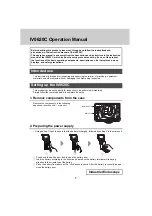
14
3-8. Complete Calibration
Before performing complete calibration procedure, verify that instrument is out
of calibration, by performing calibration check procedure (section 3-4), page 10.
If instrument is out of calibration, before performing complete calibration proce-
dure, remove bezel/lens and inspect switch mechanism to verify the following (see
Figure 3-5) (See Warning on pg. 9):
• The roller rotates without
wobble or binding.
• The cam does not touch the
roller side shields.
• The actuator arm moves
freely on its pivot.
• All switch mounting screws
are tight.
• Linkages are straight and do not
bind at the pivots.
Correct any problems that are encountered.
a. Calibration Setup
1. Connect lamp or buzzer to switch output leads. Connect a test voltage
to switch input terminals on terminal strip. (A low voltage is recom-
mended for safety.) If relay is installed in instrument, coil voltage must
be applied to switch.
2. Unlock switch plate, back out stop screw, and move plate until roller is
positioned at top of the cam. Observe that switch does not actuate when
roller is moved from low point on cam to high point. If it does actuate,
back out plunger screw with roller on top of cam until switch de-actu-
ates.
3. Advance plunger screw until switch actuates, then advance plunger
screw an additional 60° (one flat).
4. Exercise switch roller across top of cam to verify steady operation.
Advance stop screw to touch switch, then back out screw 1.5 turns
(9 flats).
b. Calibration Procedure
(see
Figure 3-6)
To calibrate switch linkage (required
when instrument is rebuilt), proceed
as follows:
1. Loosen three linkage
screws and turn crank to 12
o’clock position.
2. Use a 1/8-in. Allen wrench
to hold index shaft and
slip index pointer to 0 on
switch index.
figure 3-5.
Cam/follower Position
figure 3-6.
linkage arrangement















































